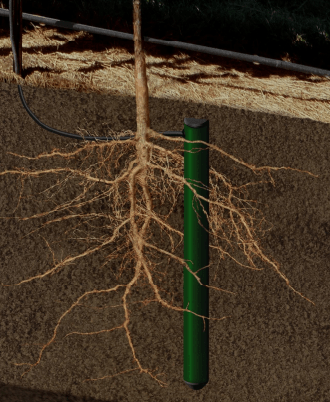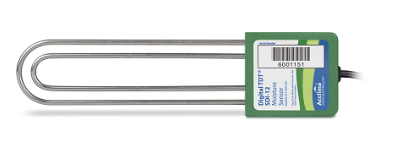Soil sensors are essential tools for modern agriculture. Good irrigation management gives better crops, uses fewer inputs, and increases profitability. Soil sensors aid good irrigation management. They are useful tools to help irrigators understand what is happening in the root zone of their crops.
Essentially, a soil sensor measures the quantity of water contained in media such as soil, on a volumetric or gravimetric basis.
There are two main groups of soils soil sensors:
- water potential soil sensors, such as tensiometers and granular matrix soil sensors.
- soil moisture soil sensors that give a percentage or relative content of soil moisture.
Instrument Choice focuses on soil sensors that capture soil moisture, rather than water potential.
Water Potential Soil Sensors
These soil sensors measure the difficulty of removing water from the soil, which provides an excellent indication of water availability for plants. While soil type and water content influence the amount of suction required to remove water from the soil, recording and charting measurements will highlight any major changes that indicate that water has become hard for a plant to access.
Tensiometer Soil Sensors
Tensiometers work by measuring suction pressure at the tensiometer's porous tip. Water is drawn out of or into the tip, depending on water availability. This in suction pressure, which indicates the relative suction force required for a plant to obtain water from the soil. Measurements can be obtained by reading a vacuum gauge, or automatically recorded via a logging pressure transducer.
Tensiometers are the most responsive water potential sensor, but they require the most care and maintenance. These are supplied in two types: one has a tip suitable for use in sand, and the other with a tip for clays and loams.
Granular Matrix Soil Sensors
Granular matrix soil sensors are reliable, generally low cost but less accurate soil sensors. They work by passing a current across a porous media, such as gypsum, with the resulting changes in electrical resistance indicating the amount of water drawn in and out of the soil.
The main disadvantage of this these soil sensors is their accuracy. They are prone to generate readings that underestimate plant stress, particularly during conditions where soil is rewetted.
Water Content Soil Sensors
These soil sensors measure the water content of a soil using the time or frequency of a pulse travelling between or returning to electrodes. The most common types are capacitance and time or frequency domain. Most soil sensors are accurate within 2–3% of the actual soil moisture.
Capacitance Soil Sensors
Capacitance soil sensors are usually deployed to measure several depths at intervals of 10 to 20cm and supplied in lengths from 40 to 180cm. Multiple depth measurement produces useful information on water movement through the soil profile and relative moisture content of the soil at different depths.
Time and frequency Domain Soil Sensors
There are two groups of this category of soil sensor; i) true time domain reflectometry (TDR) and ii) soil sensors that measure using water content reflectometry (WCR) and time domain transmissometry (TDT). The former is a complex and more expensive technology compared to the latter.
This type of sensor generally consists of 2 or 3 metal prongs between 5 and 30cm long that are pushed into the side of a soil pit to measure the undisturbed soil. The measurement extends to about 3 to 6cm around the sensor, giving a larger volume of soil measured (0.3 to 8L).
If deployed correctly, time and frequency domain soil sensors provide measurements that are more representative of the whole area of the soil if compared to capacitance soil sensors. They are also less affected by soil salts.
Soil tension calibrations are required in order to derive accurate indications of water availability with time or frequency and capacitance soil sensors. Without calibration, estimation of water availability relies on plotting measurements over time and interpreting any changes in the resulting curve.
Popular examples Of Soil Sensors
Please note, to ensure more useful data Instrument Choice scientists strongly recommend that the indicative scientific instruments profiled below be coupled with other devices, principally dataloggers. Many soil sensors also measure other variables such as temperature and salinity.
Enviropro Soil Sensors

The EnviroPro is a high-performance multi-function sub-surface soil probe suitable for monitoring soil moisture, salinity and temperature in all soil types and features sensors located at every 10cm for a full soil profile.
Fully encapsulated and sealed which makes them reliable and very stable and virtually maintenance free, the EnviroPro is compatible with any logger that supports SDI-12 interface.
Soil moisture readings are compensated for the effects of temperature and soil conductivity, giving you confidence in your readings.
Click here for a detailed description and specifications.
Digital TDT SDI-12 Soil moisture and conductivity sensor - ACC-SEN-SDI

This soil moisture sensor represents a revolutionary advance in the irrigation industry and is now available as a research tool. The digital soil moisture sensor is a very effective tool to log moisture data for a variety of applications.
It is the first moisture sensor to incorporate the accuracy of digitized Time Domain Transmissometry in a low-cost instrument, providing highly accurate absolute readings of soil moisture under all conditions of temperature and soil chemistry under which crops will grow.
What does the TDT SDI-12 measure?
- Absolute volumetric water content (expressed as a percentage)
- Soil Temperature
- Soil Conductivity
- Soil Permittivity
If you have any questions at all regarding Instrument Choice’s products, if you can’t find the soil sensor you’re looking for, or you need advice with an application, setting up your equipment, or designing an experiment contact an Instrument Choice scientist.





